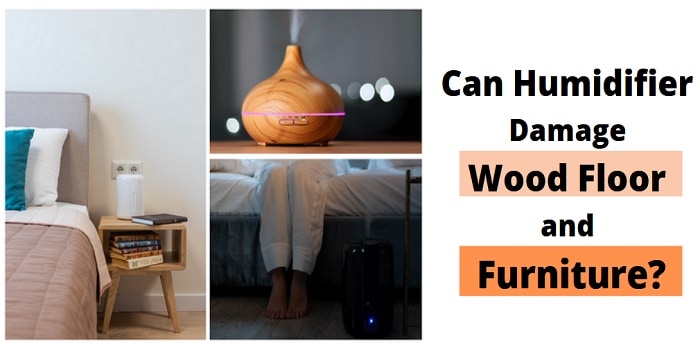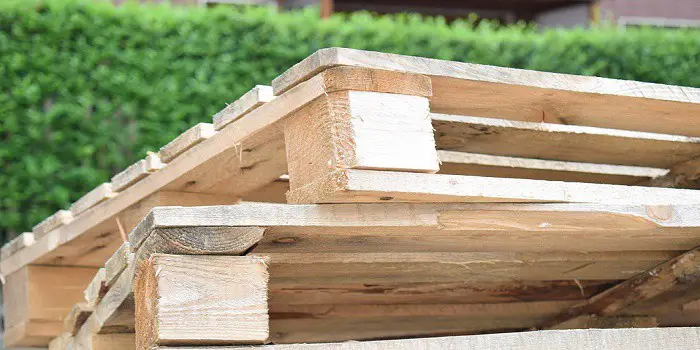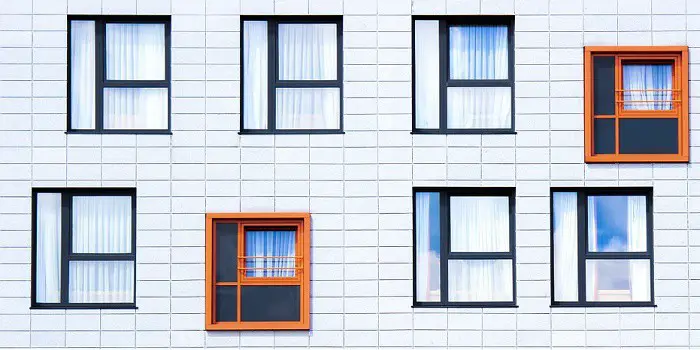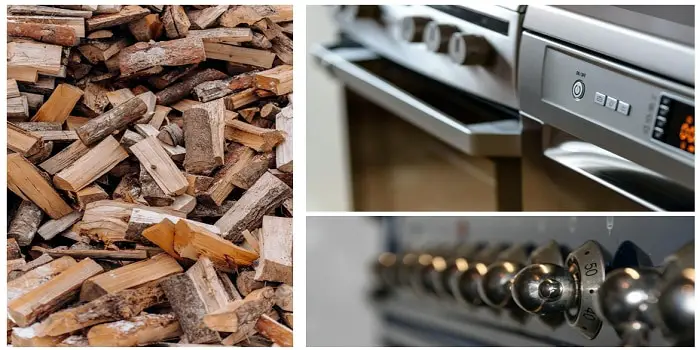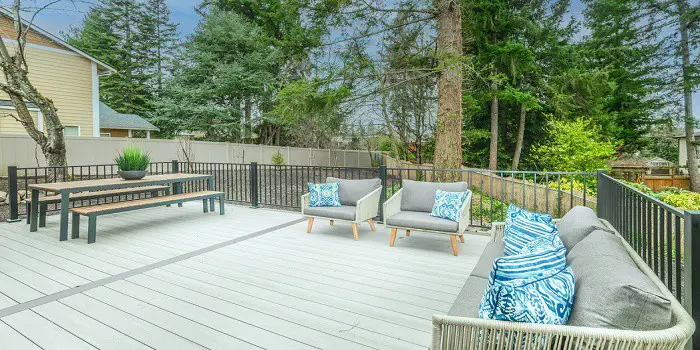
For years decks were made primarily from wood. One of the main downsides of wood has always been its vulnerability to heat and moisture.
However, in recent years, composite timber has become a hot choice for usage in deck construction, and to a large degree, it has helped address the common issues with wood.
But do composite decking materials also warp?
The honest answer is that composite does warp, but the upside is that it does so at a far slower rate than traditional wood decking.
The factors that decide how soon the warping begins include the composite materials’ plank density, constitution, engineering quality, joist spacing, and strength of synthetic binders.
Even composite timber, like the popular Trex, offers many new decking options which will warp with time and exposure to the elements like the sun. But as not all composite materials for decks are created equal, they all have different warping tendencies.
Environmental elements are a significant factor in the warping of composite decking. But there is much of a human element involved.
So, the more care the deck owner applies to their decking composite, the less frequently warping the material will occur as a general rule of thumb.
Causes Of Warping in Composite Decks
There tend to be five primary causes for the warping of composite decking material:
1- Plank Density
The composite material’s composition directly affects the density and/or hollowness levels. And when the density of plank material is strong, so will the resistance to warping.
For instance, the composites formed from high-density polyethylene and a softwood chips mixture are of a lesser density than that composed of recycled hardwood and high-density polypropylene.
2- Weather
Although not as fast as real timber, composite decking unprotected from the elements still tends to be affected by warping vulnerabilities because wind, sunlight, rain, humidity, and dryness, as well as cold and warm weather extremes, directly affect the integrity of the material.
Perpetual exposure expedites the warping potential of the composite material. For instance, constant exposure to rain leads to quicker development of rot which ends up with the deck beginning to experience curving.
Persistent exposure to the sun’s UV rays and temperature changes also affects composite materials, making them expand and contract. Allowing for proper expansion gaps when laying composite decking is therefore essential.
Also, the extreme temperature changes, wear the synthetic binders that keep the composite material together. And as these wear down, the material becomes weaker and more susceptible to warping.
3- Poor Joist Spacing
One of the most important things during the deck construction process is the placement of joists with sufficient space between them to properly balance the weight of the planks on the deck.
There is, however, no one perfect method for joist spacing because every deck requires slightly different joist spacing. But the improper arrangement of joists does have a common downside of affecting the integrity of decks.
There is some typical joist install rules of thumb in decking. And as the joists support the deck’s entire structure, essentially serving as the deck’s bones, it’s good to keep them in mind…
- When the spacing between joists is too large, it adds additional stress on the boards, leading to higher chances of warping.
- Residential decks should not exceed 16 inches between the centers of the joists, while commercial decking’s distance between joists can be just 1 foot.
- Because stairs and landings typically absorb more weight in smaller spaces, the joists underneath them should be more tightly packed.
4- Poor Deck Maintenance
You can take many preventable, easy-to-take actions to extend the life of composite decks, but unfortunately, many people ignore them.
Spilled liquids or water pooling, if not mopped up immediately, eventually get absorbed by the material, which slowly (but surely) promotes rot.
Using planks that are untreated for construction is another common mistake made.
Failing to adjust loose screws to the joists under the deck adequately or simply subjecting the deck to too much weight are other everyday poor deck maintenance habits.
5- Composite Decking Constitution
Recycled wood and plastic are the main components that comprise composite materials. However, the type of wood flour and plastic at their source varies.
Some wood sourcing includes hardwood flour, softwood flour, or bamboo flour. At the same time, plastics can be made from polyethylene or polypropylene.
Any mixture of these and the usage of plywood, PVC, or natural wood/bamboo fibers results in a different constitution of composite decking materials.
The mixture and makeup of the composite material are directly tied to the material’s tensile strength.
When the constitution is subpar, the decking material is weaker and more vulnerable to breaks and warps. But the decks of the most robust materials hold out far more than their weaker counterparts.

DIY Repairing Warped Composite Decking
Warping has likely begun if the composite decking is less flat and straight to the naked eye now – than it was at the original installation.
You can pretty quickly tell when the planks are further removed from one another. This distancing is essentially the start of warping.
If you are savvy with power tools like saws or have a handy friend who can help you, there is a DIY method to start repairing warped composite decking issues.
You will likely need a power saw, claw bar, screw gun, replacement planks, tape measurer, and safety goggles.
Step 1: Measure the Plank
Once you have the necessary tools nearby and have put up safety gear, look under your deck to check out the joists. These will be made of wood, maybe sitting underneath composite decking to support planks, so they should be easy to spot.
Carefully observe the deck to identify the planks that are warping.
Once a plank is identified, measure the plank with your tape measurer to the most accurate measurement you can assess, informing you of the depth you will need to make when cutting your replacement plank with a circular saw.
Based on the plank measures, you will know how much you need to cut into your replacement plank; usually, these are about 1 inch in depth.
Step 2: Cut the Plank and Pry it Open
Set your circular saw to the plank’s desired depth and start sawing.
Remember to cut lengthwise, not width-wise. And make sure you stop before you reach the joist, or you will have another repair on your hands.
With a straight cut through the warped plank, you will next need to get your claw bar (or a crowbar if unavailable), though claw bars are more accessible.
Insert the bar into the composite plank that has now been split. After lining it up directly in the cut line, pry hard to separate the two portions of the plank. This will allow you to remove it quickly.
Step 3: Remove and Replace the Plank
After the composite deck is split, use your screw gun to detach all the screws along the line of the plank that connects to a joist, eradicating the plank once they are all detached.
Assuming the split was clean, measure the plank to determine what size to cut the replacement plank to.
If there is too much damage, accurately measure a plank in good shape to help cut a replacement precisely to fit in the place of the old one.
Once you know the size of the replacement, cut the new plank to replace the warped one.
Measure out the new decking piece, cutting off the excess length to make it a perfect fit for your deck.
Lay the new piece in place of the recently removed one and use the screw gone to adjoin the new plank to the joists beneath.
You can then repeat this process for any other warped planks.

What are the Different Types of Warping in Decks?
If a composite deck begins to warp, identifying the type of curl is essential before you try to fix them.
There are generally five ways it begins to manifest. These include…
a) Bow: The edges of the deck begin to bend inwards while the middle remains flat, forming a bow shape.
b) Twisting/Winding: Often resembling a twisted ribbon, this type of warping is when the wood begins to twist inwards at both ends.
c) Crook: When only one end of a plank is exposed to significant moisture levels, it tends to be the only one that begins to bend inwards. The bending shape resembles a letter C, resembling a crook.
d) Cup: This is a more extreme version of warping. In this type, the material begins to curl inwards toward the deck’s center and resembles an upside-down cup.
e) Kink: The kink is when the decking material begins to bend upward on one side, resembling an arm flexed at the elbow. In a way, it is the polar opposite of a crook.
Final Thoughts
Composites like Trex decking and trims do not warp and curl up as natural timber due to the exposure to elements like the sun, moisture, rain, and snow. But still, they end up curling due to problems such as improper installation, loose joists, and lower plank quality.
The good news is the replacement of warped planks on a composite deck does not require you to spend tons of money on hiring help. Most of the time, you can save a lot of money by fixing and straightening it on your own.
Just take your time to measure and cut new planks for your deck cautiously, and you can indeed replace the warped planks on your own.
However, if a severe issue with the joists or every plank on your deck is warped, investing in professional assistance is a better alternative.
This occurrence is rare, but since you are already facing the problems, it’s good to check how the joists are holding up. After all, they are your deck’s skeletal system, and sturdy bones are suitable for holding the body together.

Hi, I am Mark Garner a professional carpenter, woodworker, and DIY painter. I live in the small city of Peoria, Arizona as a semi-retired woodworker. I have started this blog with a simple motive to help you with my wood experience in this sector. If you like to know more about what I love doing and how it all got started, you can check more about me here.

